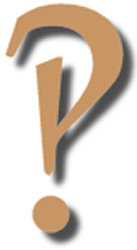Interrobang

A current interpretation of the interrobang, in Palatino Linotype
It’s a combination of an exclamation mark and a question mark. It was invented in 1962 through the advocacy of Martin Speckter, head of a New York advertising agency, Martin K Speckter Associates, which handled promotion for the Wall Street Journal, among other clients. For decades, advertising copywriters had used both marks together to imply various blends of question and exclamation. The combination might indicate a rhetorical question allied with an exclamation, or a shout of wonder and curiosity. It may also mark that mixture of incredulity and dismay which any parent may produce at stressful moments: “You did what?!”
Mr Speckter asked the readers of TYPEtalks Magazine, which he then edited, to suggest a shape and a name for the character. A lot of replies came in, suggesting names such as rhet, exclarotive, and exclamaquest. He chose interrobang. It combined interrogation, for the question mark, with bang, a printer’s term for the exclamation mark, a usage since taken over into computing.
At first, it was positively received:
The “?” at the end of “How do you do?” doesn’t always indicate just the tone of voice a writer wants to convey. The proposed interrobang, which for mechanical reasons cannot be here displayed, would indicate more accurately the degree of pleasure, curiosity and maybe surprise —all in one — the writer intended “How do you do” to deliver. An interrobang would be just right, also, to punctuate a rhetorical accusation, such as “Who forgot to put gas in the car?” where a plain question mark alone just isn’t adequate.
Wall Street Journal, 6 Apr. 1962.
In 1966, American Type Founders issued a metal typeface called Americana which included the interrobang. This was the peg for a comment in Time:
If the interabang gains the acceptance of grammarians, printers and writers, it will be the first punctuation symbol to enter the printed language since the introduction of the quotation mark during the late 17th century. Some typographical experts have already hailed its unique ability to express the ambiguity, not to mention the schizophrenia, of modern life. The interabang, cracks Harvard University Press’s monthly bulletin the Browser, “might with profit appear editorially at the end of all remarks from the political platform and the pulpit.”
Time, 21 Jul. 1967. Note the spelling, which seems, despite its repetition, to be a typographical error, since interrobang is used in the preceding paragraph.
Remington Rand added an optional key for it on several typewriters in 1968. But by the end of the 1960s, the nascent popularity of the interrobang was already waning, even among advertisers and typographers, because it was considered unnecessarily bombastic. Life was sceptical:
I seriously doubt if we are going to solve the problem by creating new punctuation marks. That only clutters up a language more. ... Besides, let in one man’s interrobang and you let in every nut who is trying to express the incredibility of modern life. They’ll start hanging around typographers’ shops hoping to get their own symbols into the language to solve their own emotional needs.
Life, 15 Nov. 1968. The writer, William Zinsser, jokingly suggested amperstop (&;) “to catch that delicate moment when you want to say something more and then think better of it” and the percentoquote (%”) “to suggest that the person being quoted should be only partially believed.”
An advertisement in 1971 mischievously subverted its creator’s intent:
The interrobang. A question mark. An exclamation point. A punctuation mark that may or may not mean what it seems to mean, so it doesn’t get used much. It’s never needed at Baker & North, because our advertising programs make clear sense to both our clients and their prospects.
Advertisement in the Hartford Courant, 9 May 1971.
By the time Martin Speckter died in February 1988, the interrobang was quite out of favour. It’s not part of the standard punctuation canon, any more than the old ?! combination ever was, having been written off by stylists and typographers as a faded fad.
But it’s not quite dead. A reverse and upside down version has been humorously invented under the name gnaborretni (interrobang backwards) for use in Spanish sentences. An entry for interrobang appears in some American dictionaries, the mark is in one Windows symbol font that I know of, and it’s also in the Unicode character set, which means that if we ever feel we need it, it will always be to hand.

